A Study of the Lichenized, Lichenicolous, and Allied Fungi of Northeast Ohio
Abstract
Since the late months of 2016, the author has extensively surveyed the natural areas throughout Northeast Ohio for all lichenized, lichenicolous, and allied fungi. This was done in order to create the first comprehensive baseline list for the region. As a result, a total of 405 recognized species have been discovered, and of these, 112 are being reported for the first time in Ohio.
Introduction
Northeast Ohio is an example of a region that is both heavily impacted by development and biologically diverse (Crooks et al., 2004; Tuovinen & Hsu, 1982). Though there has been much fragmentation of natural areas through urbanization and suburbanization, it still holds a plethora of unique and diverse habitats (Scheiring & Foote, 1973). This diversity in habitat likely contributes to the relatively large number of species that reside within the region. One group in particular, lichens, has been largely overlooked even by the naturalist community and much about them has been hidden beneath a veil of obscurity. Many of them, up to this point, have been passed by unnoticed for centuries and only now are beginning to be reported.
Nevertheless, Ohio has a relatively rich and distinguished history of lichen collection and documentation (Lendemer, 2017). In more recent decades, most information regarding lichens in Ohio has been collected and managed by Ray Showman who, himself, has done much work with the study (Showman & Rudolph, 1971; Showman, 1997; McClenahen et al., 2012; Showman, 1972A; Showman, 1972B; Showman, 1981; Showman, 1975). However, during this time, macrolichens were the primary focus for these scientists as the literature for these species was much more developed (Andreas et al., 2007).
The microlichens (crustose lichens) were notoriously difficult and not much literature was available (Wadleigh & Blake, 1999; Thomson, 1984). Only in recent years have microlichens been given significant attention by taxonomists, and now Ohio is ready to add these to its list of known biological diversity.
Since the late months of 2016, the author has been conducting numerous surveys throughout the region in order to document lichenized, lichenicolous, and allied fungi and form the first comprehensive baseline list for Northeast Ohio. This work is the kind that never really ends, but here, an attempt is made to form a list that can be referenced in the future by other experts and enthusiasts with the same mission. It is meant to be a continuation of “A STUDY OF THE MACROLICHENS OF NORTHEAST OHIO” (Curtis, 2017) published in the 2017 OBELISK newsletter. Most of the noteworthy findings of this continuation are crustose lichens, lichenicolous fungi, and lichen allies which have never been thoroughly surveyed in the region before. Ultimately, this information could be used in legislation to protect these delicate organisms from further harm.
Materials and Methods
For this study, Northeast Ohio has been defined as 13 counties clumped within the Northeast portion of the State and are indicated by the map featured in Figure 1. These counties are Ashtabula, Columbiana, Cuyahoga, Geauga, Lake, Lorain, Mahoning, Medina, Portage, Stark, Summit, Trumbull, and Wayne. All the counties within the study area have been visited at least once except for Lorain County which features very few natural areas. Some counties, such as Portage and Summit, have been explored extensively, and nearly every natural area within them has been visited.
As a casual study, there is undoubtedly some bias regarding area visitation. Most of the study area is within the Glaciated Allegheny Plateau, but parts of the Lake Plain and Unglaciated Allegheny Plateau are also within the study area. It is no surprise that many Appalachian species are only known from the small portions of Unglaciated Allegheny Plateau in Columbiana County. This is also true for Great Lakes species where they are only known from counties that border Lake Erie.
Figure 1. Map of Study Area
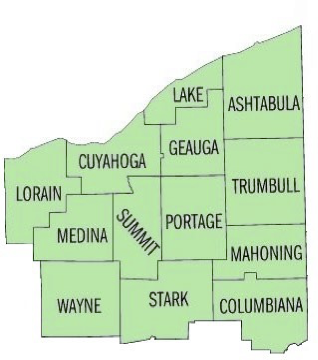
When surveying for lichens, the author targeted high quality natural areas and obtained collecting permits when necessary. The areas were then inventoried by foot. Various types of surveys were conducted including plots or meander surveys and including all-species inventories or merely collecting notable and/or interesting finds. Lichens were collected using various rock chisels (1/2”-3/4”) and a 2.5 lb. sledgehammer or a 2” wood chisel and hammer depending on the substrate. Collections were then transported in polyethylene bags and taken to a lab to be examined. Specimens were identified through studying morphological characters, microscopic characters (using a dissecting and/or compound microscope), or through studying chemistry (using spot test reagents).
Nomenclature adhered primarily to Essinger’s most recently published North American checklist (Esslinger, 2018), though special attention has been given to genera not well understood in NA such as Verrucaria. In this case, European literature (Krzewicka, 2012 and Orange, 2013) was used to name species. Many of the Verrucaria species reported here likely represent new occurrences for North America, though not all of them matched the description of any described species.
Results of microscopic and chemical analyses were recorded on herbarium labels where appropriate. All specimens collected were deposited at the Tom S. and Miwako K. Cooperrider Herbarium (KE) at the Kent State University main campus. The specimens are in the process of being digitized and are now mostly accessible through an online database. Over 2,200 specimens collected during this study within Northeast Ohio have now been databased by the author, and numerous others await digitization.


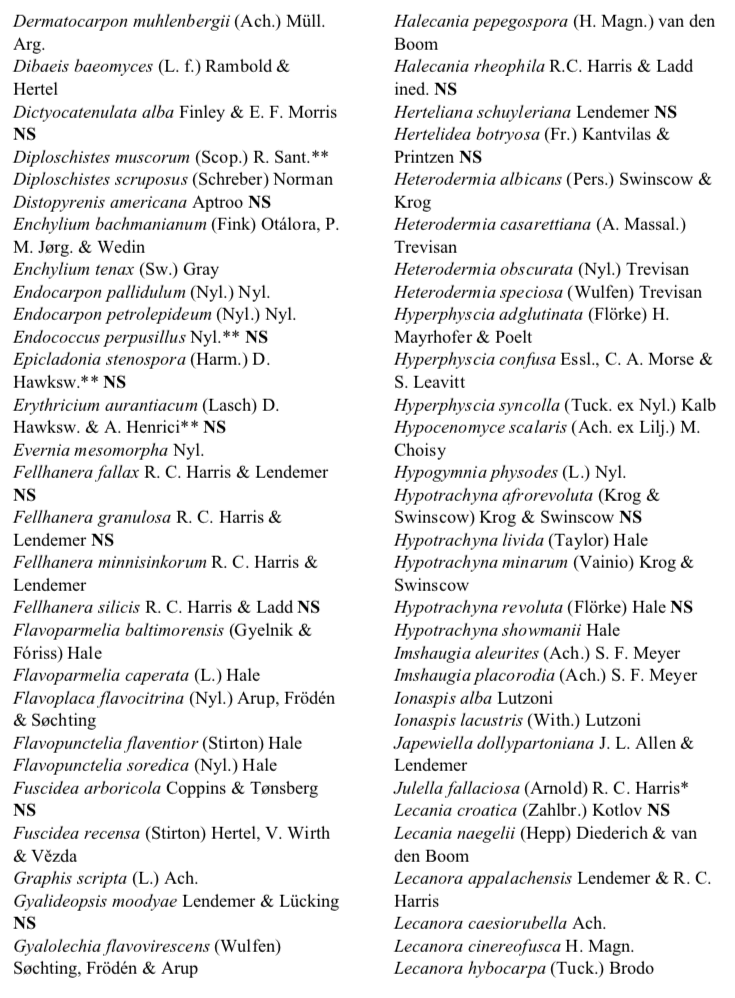

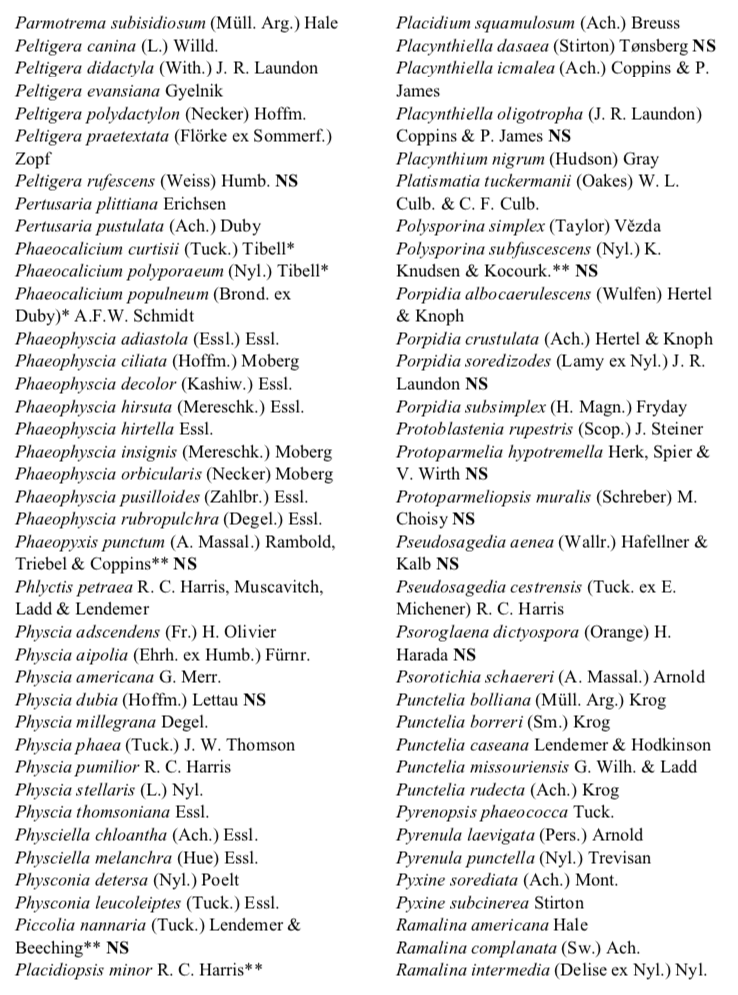
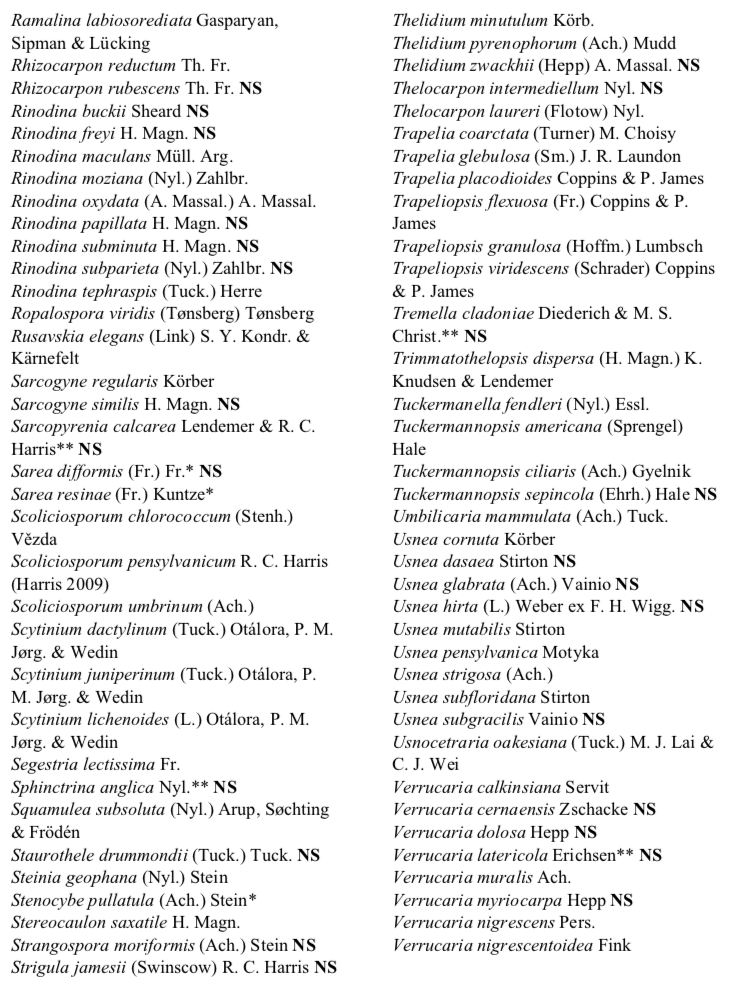
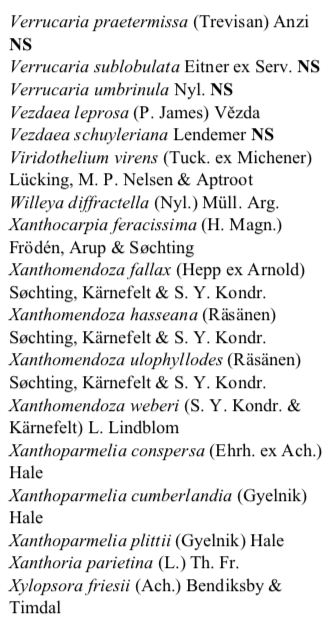
Results
The current number of recognized species found during this study is 405, including 19 lichenicolous fungi (fungi which grow on lichens) and 22 allied fungi (fungi related to lichenized counterparts). Of these, 112 have never been collected in Ohio before (based on the Consortium of North American Lichen Herbaria database) and are, therefore, new to the state. Most of the new species found during this study are microlichens, although 11 macrolichens were also new. All of the recognized species are included in the following comprehensive list, though several apparently undescribed species found are not included here and are under investigation. In addition, a list of errors discovered by the author in the 2017 article are included.
Errors in “A STUDY OF THE MACROLICHENS OF NORTHEAST OHIO (Curtis, 2017)”
- Cladonia cryptochlorophaea, C. grayi, and C. chlorophaea have been combined under the “C. chlorophaea complex” since TLC has not been performed on any of these specimens collected during this study and no morphological characteristics separate them.
- Cladonia humilis = misidentifications of C. conista
- Leptogium austroamericanum = misidentification of L. cyanescens
- Parmotrema ultralucens = misidentification of P. subisidiosum
- Physcia caesia = misidentification of P. dubia
- Scytinium subtile = misidentification of S. dactylinum
Conclusion
Through extensive inventorying of lichenized, lichenicolous, and allied fungi in NE Ohio, an entirely new level of understanding of these ubiquitous organisms has been achieved. A total of 112 species are being reported here for the first time in Ohio. The study of lichens in Ohio has reached a new level of depth and, perhaps, could be used for conservation efforts in the future. Representation of the lichens of NE Ohio in herbaria has also been increased considerably and now is more representative of the study, in a comprehensive sense, than ever before. A continuation of this study will undoubtedly yield more new and interesting discoveries in the future.
Literature Cited
Andreas, B.K., R.E. Showman and J.C. Lendemer (2007). The 2006 Combined Crum/Tuckerman Workshop in Ohio. Evansia 24: 55- 71.
Crooks, K. R., Suarez, A. V., & Bolger, D. T. (2004). Avian assemblages along a gradient of urbanization in a highly fragmented landscape. Biological conservation, 115(3), 451-462.
Curtis, T. J. (2017). A Study of the Macrolichens of Northeast Ohio. Ohio Moss and Lichen Association, OBELISK Volume 14 No. 1.
Esslinger, T. L. 2018. A cumulative checklist for the lichen-forming, lichenicolous and allied fungi of the continental United States and Canada, Version 23. Opuscula Philolichenum 17: 6-268
Krzewicka, B. (2012). A revision of Verrucaria sl (Verrucariaceae) in Poland. Polish Botanical Studies, 27(3), 143.
Lendemer, J. C. (2017). New and Interesting Records of Lichens and Lichenicolous fungi from Ohio. OBELISK Vol. 14 No. 1 McClenahen, J. R., Showman, R. E., Hutnik,
R. J., & Davis, D. D. (2012). Temporal changes in lichen species richness and elemental composition on a Pennsylvania atmospheric deposition gradient. Evansia, 29(3), 67-74.
Orange, A. (2013). British and Other Pyrenocarpous Lichens. National Museum of Wales Version 2
Scheiring, J. F., & Foote, B. A. (1973). Habitat distribution of the shore flies of northeastern Ohio (Diptera: Ephydridae).
Showman, R. E. (1972A). Photosynthetic response with respect to light in three strains of lichen algae.
Showman, R. E. (1972B). Residual effects of sulfur dioxide on the net photosynthetic and respiratory rates of lichen thalli and cultured lichen symbionts. Bryologist, 335-341.
Showman, R. E. (1975). The foliose and fruticose lichen flora around the Muskingum River Power Plant, Morgan County, Ohio.
Showman, R. E. (1981). Lichen recolonization following air quality improvement. Bryologist, 492-497.
Showman, R. E. (1997). Continuing lichen recolonization in the upper Ohio River Valley. Bryologist, 478-481.
Showman, R. E., & Rudolph, E. D. (1971). Water relations in living, dead, and cellulose models of the lichen Umbilicaria papulosa. Bryologist, 444-450.
Thomson, J. W. (1984). American Arctic Lichens: The Microlichens (Vol. 2). Univ of Wisconsin Press.
Tuovinen, O. H., & Hsu, J. C. (1982). Aerobic and anaerobic microorganisms in tubercles of the Columbus, Ohio, water distribution system. Appl. Environ. Microbiol., 44(3), 761-764.
Wadleigh, M. A., & Blake, D. M. (1999). Tracing sources of atmospheric sulphur using epiphytic lichens. Environmental Pollution, 106(3), 265-271. Workshop in Ohio. Evansia.
Tomás J. Curtis, Kent State University
(published in OBELISK, Vol. 16, p. 2-9)
